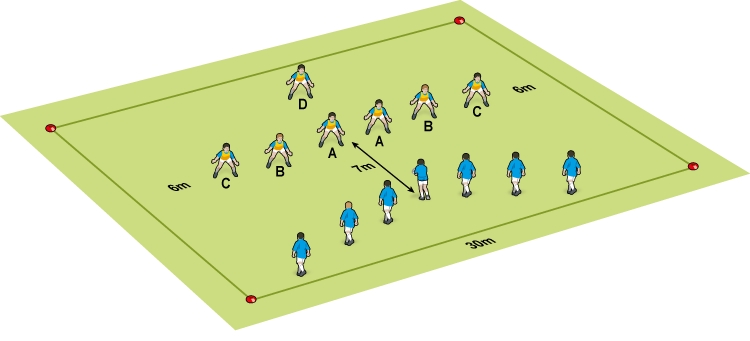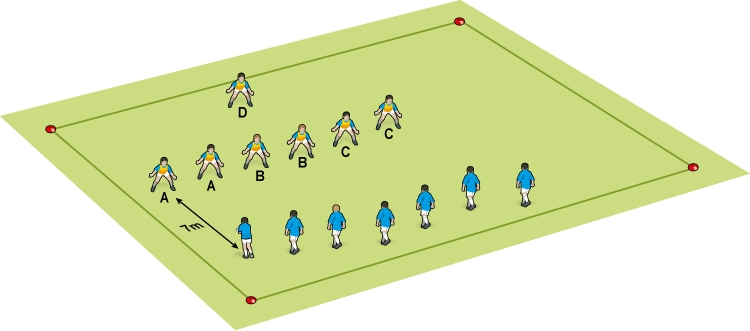You are viewing
1 of your 2 free articles
Ask Dan - Defensive line speed for an under 9s team
QUESTION
Dear Dan,
We’d like to do some defensive line-speed drills for our under-nines.
I’m trying to impress on them the need to push up as a line, but not for one or two of them to run headlessly out of the line (because they are young and keen) at the restart after a try or turnover.
ANSWER
Line speed is the defensive line coming forward quickly and in an organised state.
It certainly puts pressure on the attack, but it is notoriously tough to coach, even at the senior level.
However, that doesn’t mean you can’t start putting in place some organisation. Here are some ideas to work with.
ROLES
Pair off your defenders and label them A, B, C and D.
Your best defenders are the As, the next are the Bs. The D, who is the fifth best defender, is placed in the ’full-back’ role, and your weakest defenders (Cs) are on the wings. If you play six-a-side, use one ’winger’ and one ’full-back’.
On every restart, the As start opposite the ball carriers, the Bs either side and so on. When you sub a player, make sure the players know their letters.
This gives you some semblance of organisation. But it might take some time to get the gist of this method, so don’t expect to practise it one week and run it well the next.
GAMES
Games are a great way to introduce the principles of line speed without spending time on laborious drills which are removed from the real game.
- Play touch rugby with 7m restarts. There is an immediate turnover if the ball carrier is touched before they make 3m. Remember, the restart needs a pass.
- Play touch rugby where, if a touch is made within 5m of the last touch laterally, there is a turnover.
- Play touch rugby where, if two players can touch the ball carrier at the same time, there is a turnover.
Empower the players
Have two defensive captains on the pitch. They can help call the line-up and make sure the players are in position.
This is better than you shouting this from the sideline.
Don’t worry!
My final piece of advice is: Don’t sweat this part of the game.
Pure line speed is not really something I would concentrate on until Under-14s, if not later. I might work on it with a representative team at U15s.
The most important thing is to work on tackle confidence and decision making. The time you might spend on defensive line speed pays far less dividend than time spent on playing attacking rugby.
It takes many weeks for a team of senior players to improve their line speed, so I would suggest that any line speed is good.
Aim for communication and confidence amongst the players as your priority.
A Best defenders
B Next best defenders
C Weakest defenders
D Fifth best defender
- Put a defender behind the line to cover a line break
- Your worst defenders are on the outside, but leave space
- Your A defenders stand either side of the restart ball player
- From a restart near the touchline, put the A defenders opposite the restart ball player
- Leave space on the outside. If they run to that space, it is easier to defend a player who is running sideways
- The order should be a pair of Bs, then a pair of Cs
Related Files
Newsletter Sign Up
Coaches Testimonials

Gerald Kearney, Downtown Las Vegas Soccer Club

Paul Butler, Florida, USA

Rick Shields, Springboro, USA

Tony Green, Pierrefonds Titans, Quebec, Canada
Subscribe Today
Be a more effective, more successful rugby coach
In a recent survey 89% of subscribers said Rugby Coach Weekly makes them more confident, 91% said Rugby Coach Weekly makes them a more effective coach and 93% said Rugby Coach Weekly makes them more inspired.
Get Weekly Inspiration
All the latest techniques and approaches
Rugby Coach Weekly offers proven and easy to use rugby drills, coaching sessions, practice plans, small-sided games, warm-ups, training tips and advice.
We've been at the cutting edge of rugby coaching since we launched in 2005, creating resources for the grassroots youth coach, following best practice from around the world and insights from the professional game.















